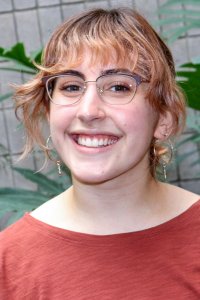Glowing Results
Ohio Wesleyan Senior Completes Plant Gene Research at Cornell University Affiliate

Name: Isa Johnson ’22
Hometown: Pittsburgh, Pennsylvania
Majors: Botany and Microbiology
Minors: Chemistry and Environmental Science
OWU Connection Experience: Summer Research Experience for Undergrads (REU) at the Boyce Thompson Institute, a Cornell University affiliate
Johnson completed a 10-week summer internship in the Plant Genome Research Program at the Ithaca, New York-based Boyce Thompson Institute, a recognized leader in agricultural and environmental scientific research.
According to the institute, its Plant Genome Research Program “focuses on training and inspiring the next generation of scientists to help feed a growing population, while protecting the environment and enhancing human health.”
Johnson, one of 28 college students nationwide chosen for this summer’s program, conducted an “Investigation of a Hornwort Insertion Line with Rhizoids Specific GFP Expression.” Her work involved inserting a gene that glows under ultraviolet light into the hornwort plant to better understand how it grows. She worked in the laboratory of plant biologist Fay-Wei Li, Ph.D.
What I’m Researching
“My project focused on studying hornwort genomes through the investigation of biolistic fluorescent gene expression. Hornworts as a model species are very important. Since they are a bryophyte, like mosses and liverworts, they share a common ancestor with vascular plants around 500 million years ago.
“So, studying the genetics of this plant will help to understand plant evolution of vascular plants from their algal ancestors. Not only that, but hornworts have cyanobacteria symbioses that help fix nitrogen, an important plant nutrient, from the atmosphere and make it soluble for plant uptake.
“These plants are also the only land plant that still has pyrenoid structures found in algae, which sequester more carbon in a smaller amount of time than chloroplasts in a land plant. Understanding more about hornwort genetics will get us one step closer to implementing them in crop plants, which will increase agricultural productivity.”
Illuminating Results
“Specifically, my project focused on an insertion of a GFP gene (which fluoresces under UV light) into the model hornwort species Anthoceros agrestis using a gene gun. The insertion was interesting because the fluorescent gene was only expressed in the rhizoid tissue (little root-like structures of the hornwort), though the gene was inserted in a place we thought would affect the entire genome.
“This gave us a pathway to further understanding the genetic factors that affect hornwort gene expression – specifically doing syntenic analysis to understand if this region of expressed GFP is silenced by epigenetic factors in all tissues of the hornwort except for the rhizoids.”
Why I Chose This Experience
“This experience gave me an opportunity to contribute to a project using cutting-edge research with a fairly under-studied model species that few labs around the world are working on.
“Therefore, I saw this as a one-of-a-kind experience working with experts in the field that were professors at Cornell University as well as full-time researchers.
“With that, my work on this project furthers our study in using the special characteristics found in hornworts to make agricultural advancements, which is important to me because this research will inevitably help people and contribute to the wealth of plant knowledge needed to feed a growing population.
“I was also able to present my findings at a symposium with other researchers, which is important in curating my scientific communication skills.”
My Favorite Moment
“My favorite moment of this experience has to be when I met my mentor and a post-doctorate student that I would work with for the first time. I explained my experiences at Ohio Wesleyan that had prepared me for my experience at BTI, and I even found out that we had some shared experiences.
I had told them about my work at the OWU herbarium and both of them told me about how they worked at the herbarium at the Smithsonian. It was very wonderful to see my experiences shared with others in the field that I want to go into.”
Lessons Learned
“The most important lesson I learned from this experience is that science takes time, and failure is almost guaranteed.
“I remember in the beginning of the project I was very excited to get results and when results did not come out like I wanted or took a long time to happen, I got impatient and felt like a failure. I was reassured many times that this is just the pace of the scientific method and that I was doing great for an intern who only had a summer to complete a whole research project.
“I think in this way, this experience showed me something I would never learn in the classroom and something that will help me for the rest of my future career in science; that it takes time and a lot of failure to get noteworthy success.”
My OWU Mentors
“I did not work on this project with a faculty mentor from OWU, but I had many faculty mentors at Ohio Wesleyan who supported me throughout my entire experience. I had shared my project proposal with Dr. David Johnson, Dr. Nancy Murray, and Dr. Chris Wolverton who have all been pertinent in my education at OWU and gave me the materials needed to succeed at BTI.”
Why I Chose Ohio Wesleyan
“I chose Ohio Wesleyan because of its focus on plant science. The faculty that I would be learning from and the facilities such as the greenhouse and the herbarium were all important in making my decision to come to OWU. I saw professors that I would be learning from doing fascinating research and working in the facilities that I hope to work in once I’m done with school.”
My Plans After Graduation
“After graduation I hope to attend graduate school to get my doctorate. I know I would not be able to navigate applying to doctorate programs or applying for grants if it wasn’t for the guidance of the faculty at OWU.”
